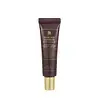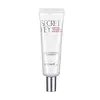What's inside
What's inside
 Key Ingredients
Key Ingredients

 Benefits
Benefits

 Concerns
Concerns

No concerns
 Ingredients Side-by-side
Ingredients Side-by-side

Saccharomyces/Snail Secretion Filtrate Ferment Filtrate
Skin ConditioningWater
Skin ConditioningCaprylic/Capric Triglyceride
MaskingPropanediol
SolventLactobacillus/Collagen Ferment Filtrate
HumectantButylene Glycol
HumectantPolyglyceryl-3 Methylglucose Distearate
EmulsifyingNiacinamide
SmoothingCetyl Ethylhexanoate
Emollient1,2-Hexanediol
Skin ConditioningPentylene Glycol
Skin ConditioningGlyceryl Stearate
EmollientGlycerin
HumectantAcrylates/C10-30 Alkyl Acrylate Crosspolymer
Emulsion StabilisingHydroxyethylcellulose
Emulsion StabilisingOlea Europaea Fruit Oil
MaskingHelianthus Annuus Seed Oil
EmollientSodium Hyaluronate
HumectantSodium Hyaluronate Crosspolymer
HumectantHydrolyzed Sodium Hyaluronate
Skin ConditioningHydrolyzed Hyaluronic Acid
HumectantHyaluronic Acid
HumectantAcetyl Hexapeptide-8
HumectantCopper Tripeptide-1
Skin ConditioningBifida Ferment Lysate
Skin ConditioningUlmus Campestris Bark Extract
AstringentSalix Alba Bark Extract
AstringentPlantago Asiatica Extract
Skin ConditioningLaminaria Digitata Extract
Skin ProtectingDiospyros Kaki Leaf Extract
Skin ProtectingAlthaea Rosea Root Extract
HumectantAloe Barbadensis Leaf Extract
EmollientBetaine
HumectantBeta-Glucan
Skin ConditioningGlyceryl Stearate Citrate
EmollientPanthenol
Skin ConditioningGlycine
BufferingSerine
MaskingGlutamic Acid
HumectantAllantoin
Skin ConditioningAspartic Acid
MaskingLeucine
Skin ConditioningAlanine
MaskingLysine
Skin ConditioningTyrosine
MaskingPhenylalanine
MaskingValine
MaskingThreonine
Proline
Skin ConditioningIsoleucine
Skin ConditioningHistidine
HumectantMethionine
Skin ConditioningCysteine
AntioxidantArginine
MaskingCeramide NP
Skin ConditioningAdenosine
Skin ConditioningBee Venom
AstringentTocopherol
AntioxidantPolyglyceryl-3 Distearate
EmulsifyingHydrogenated Lecithin
EmulsifyingCetearyl Olivate
Sorbitan Olivate
EmulsifyingCaprylyl Glycol
EmollientSaccharomyces/Snail Secretion Filtrate Ferment Filtrate, Water, Caprylic/Capric Triglyceride, Propanediol, Lactobacillus/Collagen Ferment Filtrate, Butylene Glycol, Polyglyceryl-3 Methylglucose Distearate, Niacinamide, Cetyl Ethylhexanoate, 1,2-Hexanediol, Pentylene Glycol, Glyceryl Stearate, Glycerin, Acrylates/C10-30 Alkyl Acrylate Crosspolymer, Hydroxyethylcellulose, Olea Europaea Fruit Oil, Helianthus Annuus Seed Oil, Sodium Hyaluronate, Sodium Hyaluronate Crosspolymer, Hydrolyzed Sodium Hyaluronate, Hydrolyzed Hyaluronic Acid, Hyaluronic Acid, Acetyl Hexapeptide-8, Copper Tripeptide-1, Bifida Ferment Lysate, Ulmus Campestris Bark Extract, Salix Alba Bark Extract, Plantago Asiatica Extract, Laminaria Digitata Extract, Diospyros Kaki Leaf Extract, Althaea Rosea Root Extract, Aloe Barbadensis Leaf Extract, Betaine, Beta-Glucan, Glyceryl Stearate Citrate, Panthenol, Glycine, Serine, Glutamic Acid, Allantoin, Aspartic Acid, Leucine, Alanine, Lysine, Tyrosine, Phenylalanine, Valine, Threonine, Proline, Isoleucine, Histidine, Methionine, Cysteine, Arginine, Ceramide NP, Adenosine, Bee Venom, Tocopherol, Polyglyceryl-3 Distearate, Hydrogenated Lecithin, Cetearyl Olivate, Sorbitan Olivate, Caprylyl Glycol
Water
Skin ConditioningGlycerin
HumectantHydrogenated Polyisobutene
EmollientAluminum Starch Octenylsuccinate
AbsorbentGlyceryl Stearate Se
EmulsifyingNiacinamide
SmoothingC12-15 Alkyl Benzoate
AntimicrobialPolyglyceryl-3 Methylglucose Distearate
EmulsifyingCyclopentasiloxane
EmollientBeeswax
Emulsion StabilisingGalactomyces Ferment Filtrate
HumectantSodium Polyacrylate
AbsorbentAcrylates/C10-30 Alkyl Acrylate Crosspolymer
Emulsion StabilisingGlyceryl Polyacrylate
Stearic Acid
CleansingButyrospermum Parkii Butter
Skin ConditioningAdenosine
Skin ConditioningAloe Barbadensis Leaf Extract
EmollientAnthemis Nobilis Flower Extract
MaskingCamellia Sinensis Leaf Extract
AntimicrobialCentella Asiatica Extract
CleansingBoswellia Serrata Resin Extract
SmoothingHamamelis Virginiana Extract
AntiseborrhoeicOryza Sativa Extract
AbsorbentPortulaca Oleracea Extract
Skin ConditioningPanax Ginseng Root Extract
EmollientAcanthopanax Senticosus Root Extract
Skin ConditioningSh-Oligopeptide-1
Skin ConditioningLecithin
EmollientSodium Ascorbyl Phosphate
AntioxidantMacadamia Integrifolia Seed Oil
Skin ConditioningPrunus Amygdalus Dulcis Oil
Skin ConditioningArgania Spinosa Kernel Oil
EmollientAstrocaryum Murumuru Seed Butter
EmollientSimmondsia Chinensis Seed Oil
EmollientCeramide NP
Skin ConditioningTocopheryl Acetate
AntioxidantCaprylhydroxamic Acid
Caprylyl Glycol
Emollient1,2-Hexanediol
Skin ConditioningTriethanolamine
BufferingDisodium EDTA
Parfum
MaskingWater, Glycerin, Hydrogenated Polyisobutene, Aluminum Starch Octenylsuccinate, Glyceryl Stearate Se, Niacinamide, C12-15 Alkyl Benzoate, Polyglyceryl-3 Methylglucose Distearate, Cyclopentasiloxane, Beeswax, Galactomyces Ferment Filtrate, Sodium Polyacrylate, Acrylates/C10-30 Alkyl Acrylate Crosspolymer, Glyceryl Polyacrylate, Stearic Acid, Butyrospermum Parkii Butter, Adenosine, Aloe Barbadensis Leaf Extract, Anthemis Nobilis Flower Extract, Camellia Sinensis Leaf Extract, Centella Asiatica Extract, Boswellia Serrata Resin Extract, Hamamelis Virginiana Extract, Oryza Sativa Extract, Portulaca Oleracea Extract, Panax Ginseng Root Extract, Acanthopanax Senticosus Root Extract, Sh-Oligopeptide-1, Lecithin, Sodium Ascorbyl Phosphate, Macadamia Integrifolia Seed Oil, Prunus Amygdalus Dulcis Oil, Argania Spinosa Kernel Oil, Astrocaryum Murumuru Seed Butter, Simmondsia Chinensis Seed Oil, Ceramide NP, Tocopheryl Acetate, Caprylhydroxamic Acid, Caprylyl Glycol, 1,2-Hexanediol, Triethanolamine, Disodium EDTA, Parfum
Ingredients Explained
These ingredients are found in both products.
Ingredients higher up in an ingredient list are typically present in a larger amount.
1,2-Hexanediol is a synthetic liquid and another multi-functional powerhouse.
It is a:
- Humectant, drawing moisture into the skin
- Emollient, helping to soften skin
- Solvent, dispersing and stabilizing formulas
- Preservative booster, enhancing the antimicrobial activity of other preservatives
Acrylates/C10-30 Alkyl Acrylate Crosspolymer is a synthetic polymer. It is used to thicken and improve the texture of products. Due to its properties, it can prevent water and oil ingredients from separating.
Adenosine is in every living organism. It is one of four components in nucleic acids that helps store our DNA.
Adenosine has many benefits when used. These benefits include hydrating the skin, smoothing skin, and reducing wrinkles. Once applied, adenosine increases collagen production. It also helps with improving firmness and tissue repair.
Studies have found adenosine may also help with wound healing.
In skincare products, Adenosine is usually derived from yeast.
Learn more about AdenosineAloe Barbadensis Leaf Extract is an extract of the leaves of the aloe, Aloe barbadensis, Liliaceae.
Aloe is one of the most well-known natural soothing ingredients, and for good reason. It’s full of water and has a cooling, calming effect on the skin, especially when it’s sunburned, itchy, or irritated. Aloe also helps your skin stay hydrated and smooth by mimicking what healthy skin naturally produces. On top of that, it contains vitamins and nutrients that support skin recovery.
It doesn’t protect you from the sun, but it can help your skin bounce back after too much time in it.
Let’s get into the details:
Aloe contains antioxidant Vitamins A, C, and E, which help fight off free radicals (unstable molecules from things like pollution that can damage your skin).
It’s also rich in polysaccharides, which are natural sugars that help hydrate the skin by acting like the skin’s own moisturizing agents. These, along with other sugars like monosaccharides, help form a protective barrier that locks in moisture.
Aloe works as both a humectant and an emollient. That means it draws water into the skin (humectant) and helps trap it there (emollient), making it an effective natural moisturizer.
You’ll also find a mix of other skin-supporting ingredients in aloe, including folic acid, choline, calcium, amino acids, fatty acids, and even Vitamin B12.
Out of the 420+ species of aloe, Aloe barbadensis is the most widely used in skincare products thanks to its gentle yet effective properties.
There are over 420 species of aloe but Aloe Barbadensis is the most commonly used for topical products.
Learn more about Aloe Barbadensis Leaf ExtractCaprylyl Glycol is a humectant and emollient, meaning it attracts and preserves moisture.
It is a common ingredient in many products, especially those designed to hydrate skin. The primary benefits are retaining moisture, skin softening, and promoting a healthy skin barrier.
Though Caprylyl Glycol is an alcohol derived from fatty acids, it is not the kind that can dry out skin.
This ingredient is also used as a preservative to extend the life of products. It has slight antimicrobial properties.
Learn more about Caprylyl GlycolCeramide NP is a type of ceramide and formally known as ceramide 3.
Ceramides are intercellular lipids naturally found in our skin that bonds dead skin cells together to create a barrier. They are known for their ability to hold water and thus are a great ingredient for dry skin.
Ceramides are an important building block for our skin barrier. A stronger barrier helps the skin look more firm and hydrated. By bolstering the skin ceramides act as a barrier against irritating ingredients. This can help with inflammation as well.
If you would like to eat ceramides, sweet potatoes contain a small amount.
Read more about other common types of ceramides here:
Ceramide AP
Ceramide EOP
Glycerin is already naturally found in your skin. It helps moisturize and protect your skin.
A study from 2016 found glycerin to be more effective as a humectant than AHAs and hyaluronic acid.
As a humectant, it helps the skin stay hydrated by pulling moisture to your skin. The low molecular weight of glycerin allows it to pull moisture into the deeper layers of your skin.
Hydrated skin improves your skin barrier; Your skin barrier helps protect against irritants and bacteria.
Glycerin has also been found to have antimicrobial and antiviral properties. Due to these properties, glycerin is often used in wound and burn treatments.
In cosmetics, glycerin is usually derived from plants such as soybean or palm. However, it can also be sourced from animals, such as tallow or animal fat.
This ingredient is organic, colorless, odorless, and non-toxic.
Glycerin is the name for this ingredient in American English. British English uses Glycerol/Glycerine.
Learn more about GlycerinNiacinamide is a multitasking form of vitamin B3 that strengthens the skin barrier, reduces pores and dark spots, regulates oil, and improves signs of aging.
And the best part? It's gentle and well-tolerated by most skin types, including sensitive and reactive skin.
You might have heard of "niacin flush", or the reddening of skin that causes itchiness. Niacinamide has not been found to cause this.
In very rare cases, some individuals may not be able to tolerate niacinamide at all or experience an allergic reaction to it.
If you are experiencing flaking, irritation, and dryness with this ingredient, be sure to double check all your products as this ingredient can be found in all categories of skincare.
When incorporating niacinamide into your routine, look out for concentration amounts. Typically, 5% niacinamide provides benefits such as fading dark spots. However, if you have sensitive skin, it is better to begin with a smaller concentration.
When you apply niacinamide to your skin, your body converts it into nicotinamide adenine dinucleotide (NAD). NAD is an essential coenzyme that is already found in your cells as "fuel" and powers countless biological processes.
In your skin, NAD helps repair cell damage, produce new healthy cells, support collagen production, strengthen the skin barrier, and fight environmental stressors (like UV and pollution).
Our natural NAD levels start to decline with age, leading to slower skin repair, visible aging, and a weaker skin barrier. By providing your skin niacinamide, you're recharging your skin's NAD levels. This leads to stronger, healthier, and younger looking skin.
Another name for vitamin B3 is nicotinamide. This vitamin is water-soluble and our bodies don't store it. We obtain Vitamin B3 from either food or skincare. Meat, fish, wheat, yeast, and leafy greens contain vitamin B3.
The type of niacinamide used in skincare is synthetically created.
Learn more about NiacinamidePolyglyceryl-3 Methylglucose Distearate is created from the diester of stearic acid and the condensation product of methylglucose and Polyglycerin-3.
As an emulsifier, it is used to bind ingredients together. Many ingredients, such as oils and water, separate naturally. Emulsifiers prevent them from separating to ensure even consistency in texture.
One of the manufacturer for this ingredient states it is vegetable-based. It is also claimed to be stable at both high and low temperatures.
This ingredient may not be safe for fungal acne. We recommend speaking with a professional if you have any concerns.
Learn more about Polyglyceryl-3 Methylglucose DistearateWater. It's the most common cosmetic ingredient of all. You'll usually see it at the top of ingredient lists, meaning that it makes up the largest part of the product.
So why is it so popular? Water most often acts as a solvent - this means that it helps dissolve other ingredients into the formulation.
You'll also recognize water as that liquid we all need to stay alive. If you see this, drink a glass of water. Stay hydrated!
Learn more about Water